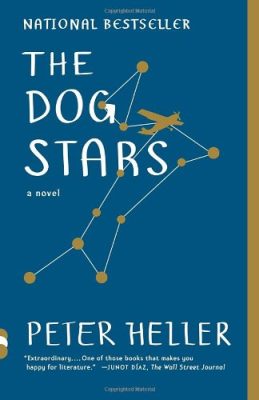
Denver resident Peter Heller is a contributor to NPR, Outside Magazine, Men’s Journal, and National Geographic Adventure. He has written literary nonfiction and fiction–and he loves the outdoors, so his writing reflects his adventures, including in Hell or High Water: Surviving Tibet’s Tsangpo River, The Whale Warriors: The Battle at the Bottom of the World to Save the Planet’s Largest Mammals, and his newest, Kook: What Surfing Taught Me about Love, Life, and Catching the Perfect Wave. See more at Heller’s website. The Dog Stars was his debut novel, published in August 2012. Since then, he has also written the novels The Painter and Celine.
***
When I asked Peter Heller if there was anything he would like to tell me about writing The Dog Stars, he said:
I believe climate change and the Sixth Great Mass Extinction–which we are in the middle of, and which has been caused by us–are the stories of our time. I think about them all the time. So, when I sat down to write my first novel, they had to inform the writing and the story.
Writers artistically document our times. They inform, create, entertain, and imagine. They warn and give hope. Sometimes they frighten us. They create new myths and expand on old ones. They have always reflected the changing world around us. In our Sixth Great Mass Extinction, like Heller said, come stories, and I believe that authors writing about this extinction are going through a period of unprecedented loss and reflection.
To learn more about the Sixth Great Mass Extinction, see National Geographic.
On Earth Day this year I took part in a panel called Climate Change and Storytelling, at the West Vancouver Public Library. Some of the main questions people asked were: How do you write about climate change in fiction, and what impacts readers the most? Is doom and gloom or cheer more effective? Authors are diverse in tackling global warming in fiction; they have their own way of storytelling–from didactic to the other end of the spectrum, not even really mentioning climate change at all. Readers are just as diverse. Some prefer science fiction. Some literary. Some like dystopia. Some can’t stomach it. Some stories, however, may hit home with almost everyone, and when I read The Dog Stars, I felt that it was one of these types of stories. However, it is a stark novel, brutal and honest to the bone.
Why Heller’s novel works so well is that it simply touches your heart, which was also our panel’s conclusions when it comes to why readers like any story, not just stories about climate change. Climate change may be a big focus in novels listed at this site, but when readers can relate to characters in the story, that’s when we get inspired. As I’ve pointed out often, impact is greater than intent.

The Dog Stars weaves an interesting story of a guy named Hig and his dog who live in an abandoned airstrip, Hig’s memories of his wife and unborn child, and his relationship with a neighbor named Bangley. Other characters enter the story: a group of Mennonites nearby and a father and daughter living “at the point of no return.” This apocalyptic novel has a conversational style, making the reader feel right at home. Hig is likeable, and the reader probably will root for Hig’s continued survival–and potential romance–in his climate-changed world where many species seem to be gone and an epidemic (“The Blood”) has wiped most people off the face of the Earth. Zoom in to Hig and his world, and you get a glimpse of Heller’s concerns for our own planet.
Heller has a deft writing style that captures loss well, but he is also all about cheering on the remaining wilderness.
There are patches of green wood, and I am their biggest fan. Go Go Go Grow Grow Grow! That’s our fight song.
He yells it out the window as he flies along in an old Cessna trying to see what’s remaining in his newly isolated existence. What’s not to immediately adore about Hig? He loves the wilderness, which is a diminishing aspect of planet Earth, but there are still signs of it. As a person who also spends a great deal of time outside, I see the woods and meadows continuing to disappear and so I revel in places that are still green, like Hig does, and I revel likewise in his prose about those places. Heller’s descriptions of woods and meadows and willows and creeks are partially why this novel hits the heart. When all these things are taken for granted, and then they are endangered, an author can bring them back with words, with warning, and with whispers of what once was–what may be in the future if we take care. John Seabrook in The New Yorker said about The Dog Stars:
The prose bears an obvious debt to manly sentence-smiths like McCarthy, Hemingway, and Jack London, but it also has lyrical descriptions of landscape and nature reminiscent of James Dickey’s poetry.1
The reader can also relate because this is a down-to-earth novel, despite its nods to stars and constellations–and its main character flying around in the sky. Hig’s narration is similar to how any one of us readers might be thinking in a similar situation. We understand the eclipse of his life, from the modern era to the apocalyptic afterworld where lamentation, nostalgia, and yet hope are big. We are already starting to view similar situations found in the novel as climate change grips us in its talons and flies us toward uncertainty.
Climate change does not have to change humanity; relationships with pets, friends, lovers, and the natural world around us will live on. Nostalgia peaks because of loss, and survival may be frightening, but all the more reason to grasp onto others who help us cope with loss–similar to what’s happening in The Dog Stars. There is an uptick to the harsh environment and world that Hig finds himself in. There are plenty of frightening individuals, but we like Hig. NPR stated:
Hig, though, is Nice. He can’t quite give up his dreams of a better world, of brotherhood, of natural beauty, of grace. A failed poet, on his forays into the wilderness to hunt for deer, his voice becomes lyrical: “The moss I wonder how old. It is dry and light to the touch, almost crumbly, but in the trees it moves like sad pennants.”2
I won’t spoil the story by telling everything that happens, but one particular event is a sad one that made me cry. And it made Hig fall into an existential lamentation. We are warned at the start of the novel that the future world is at the stage of lamentations:
Did you ever read the Bible? Check out Lamentations. That’s where we’re at, pretty much. Pretty much Lamenting. Pretty much pouring our hearts out like water.
Despite such a downfall, Hig goes on, and we are left with a heartfelt, jarring read that makes this one of my favorite stories wherein climate change is a strong force. Perhaps it is Heller’s beautiful prose writing. Maybe it’s that I identify with Hig’s love of nature and his excitement when he finds it. But, mostly, The Dog Stars is about us, in all our quirks and loves and nostalgia–and our vulnerability and found-strength when it comes to how we survive disaster.
1. “What We’re Reading: Postapocalit, Love Among the Chickens,” by John Seabrook. The New Yorker, October 26, 2012.
2. “Dog Stars Dwells On The Upside Of Apocalypse,” by Jennifer Reese. NPR Books, August 7, 2012.